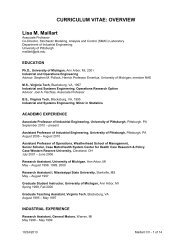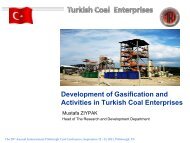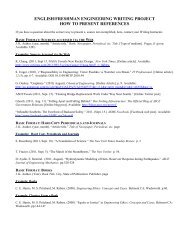Abstract Booklet 2006 - Swanson School of Engineering - University ...
Abstract Booklet 2006 - Swanson School of Engineering - University ...
Abstract Booklet 2006 - Swanson School of Engineering - University ...
Create successful ePaper yourself
Turn your PDF publications into a flip-book with our unique Google optimized e-Paper software.
and natural gas which should be partly replaced by using the available lignite. It was the<br />
intention <strong>of</strong> the government in the former GDR to build up several gasification plants in the<br />
area <strong>of</strong> Central Germany to supply major chemical companies through long-distance<br />
pipelines with syngas from lignite. Because <strong>of</strong> the low rank <strong>of</strong> lignite and the high salt<br />
content in the ash <strong>of</strong> this coal the process had special demands to the feeding system and to<br />
the gasifier itself. Passing a period <strong>of</strong> several owners after the privatization in 1991 the<br />
FUTURE ENERGY GmbH belongs to SIEMENS Power Generation since the 1st January<br />
<strong>2006</strong>. The first test facility with a thermal capacity <strong>of</strong> 3 MW, built in 1979, was used to<br />
examine the technical concept and to test the planned lignite and saliferous lignite for the<br />
erection <strong>of</strong> the large scale demonstration facility in 1984 in the Gaskombinat Schwarze<br />
Pumpe /Germany, where the name <strong>of</strong> the process “GSP” comes from. In the period 1994 to<br />
1998 further test facilities were erected at FUTURE ENERGY site in Freiberg, among this a<br />
5 MW th cooling screen reactor. Up to now these facilities have been used to gasify more than<br />
90 candidate gasification feeds - among others 35 different coals, 25 sewage sludge’s <strong>of</strong><br />
municipal or industrial provenance, petroleum coke, waste oils, bio-oils, bio-slurries and 20<br />
liquid residues, in order to investigate their gasification behavior and to analyze the quality<br />
and the characteristics <strong>of</strong> the gasification products. By this systematic research and<br />
development the field <strong>of</strong> application <strong>of</strong> the GSP Technology was enlarged from<br />
conventional fuels, such as coals and oils, through residual and waste materials and biomass.<br />
7-3<br />
Orlando Gasification Project: Demonstration <strong>of</strong><br />
a Nominal 285 MW Coal-Based Transport Gasifier<br />
Frank Morton, Tim Pinkston, Southern Company, USA<br />
Nicola Salazar, KBR, USA<br />
Denise Stalls, Orlando Utilities Commission, USA<br />
Southern Company, the Orlando Utilities Commission (OUC), and KBR are building an<br />
advanced 285-megawatt coal gasification facility near Orlando, Florida with the support <strong>of</strong><br />
the Department <strong>of</strong> Energy (DOE) under the Clean Coal Power Initiative (CCPI). The CCPI<br />
is a cost-sharing partnership between the government and industry designed to accelerate<br />
commercial deployment <strong>of</strong> advanced technologies to ensure that the United States has clean,<br />
reliable, affordable coal-based electricity, which is essential for a strong U.S. economy and<br />
domestic energy security. The proposed plant will demonstrate an Integrated Gasification<br />
Combined Cycle (IGCC) using an air-blown Transport Gasifier. Southern Company and<br />
KBR are developing the Transport Gasifier and related systems for commercial application<br />
in the power industry in conjunction with the U.S. Department <strong>of</strong> Energy (DOE). The Power<br />
Systems Development Facility (PSDF) is an engineering scale demonstration <strong>of</strong> the KBR<br />
Transport Gasifier, a high-temperature, high-pressure syngas filtration system, and gas<br />
cleanup. Built at a sufficient scale to test advanced power systems and components in an<br />
integrated fashion, the PSDF provides data necessary for commercial scale-up <strong>of</strong> these<br />
technologies.<br />
The Transport Gasifier is an advanced circulating fluidized bed system designed to operate<br />
at higher circulation rates, velocities, and riser densities than a conventional circulating bed<br />
unit. The high circulation rates result in higher throughput, better mixing, and higher mass<br />
and heat transfer rates. Since the gasifier uses a dry feed and does not slag its ash, it is<br />
particularly well-suited for high moisture fuels such as sub-bituminous coal and lignite.<br />
7-4<br />
Energy investment <strong>of</strong> the future - Nuon Magnum IGCC Power Plant<br />
Leon Pulles, Nuon, NETHERLANDS<br />
Natalie van der Burg, Capgemini, NETHERLANDS<br />
The 21st century is in need <strong>of</strong> investments in the power generation sector. This article<br />
describes the economic view on investing in this sector. In addition it entails the<br />
project development approach <strong>of</strong> a current investment project, as illustrated by the<br />
Nuon Magnum IGCC Power Plant project with a generation capacity <strong>of</strong> 1200 MWe.<br />
Capgemini is working together with Nuon and delivers project management<br />
capabilities.<br />
7-5<br />
The Exergy UCG Technology and its Commercial Applications<br />
Michael S. Blinderman, Ergo Exergy Technologies, Inc., CANADA<br />
Underground Coal Gasification (UCG) is a gasification process carried on in non-mined coal<br />
seams using injection and production wells drilled from the surface, converting coal in situ<br />
into a product gas usable for chemical processes and power generation. The UCG process<br />
developed, refined and practiced by Ergo Exergy Technologies is called the Exergy UCG<br />
Technology or UCG Technology.<br />
The UCG technology is being applied in numerous power generation and chemical projects<br />
worldwide. These include power projects in South Africa (1,200 MWe), India (750 MWe),<br />
Pakistan, and Canada, as well as chemical projects in Australia and Canada. A number <strong>of</strong><br />
UCG based industrial projects are now at a feasibility stage in New Zealand, USA, and<br />
Europe. An example <strong>of</strong> UCG application is the Chinchilla Project in Australia where the<br />
technology demonstrated continuous, consistent production <strong>of</strong> commercial quantities <strong>of</strong><br />
quality fuel gas for over 30 months. The project is currently targeting a 24,000 barrel per day<br />
synthetic diesel plant based on UCG syngas supply. The UCG technology has demonstrated<br />
exceptional environmental performance. The UCG methods and techniques <strong>of</strong><br />
environmental management are an effective tool to ensure environmental protection during<br />
6<br />
an industrial application. A UCG -IGCC power plant will generate electricity at a much<br />
lower cost than existing or proposed fossil fuel power plants. CO 2 emissions <strong>of</strong> the plant can<br />
be reduced to a level 55% less than those <strong>of</strong> a supercritical coal-fired plant and 25% less than<br />
the emissions <strong>of</strong> NG CC.<br />
8-1<br />
SESSION 8<br />
SYNTHESIS OF LIQUID FUELS, CHEMICALS, MATERIALS AND<br />
OTHER NON-FUEL USES OF COAL: APPLIED FT/CTL<br />
Coal Conversion - A Rising Star<br />
C. Lowell Miller, DOE, USA<br />
Daniel Cicero, NETL, USA<br />
Mark Ackiewicz, John Anderson, Technology & Management, USA<br />
Edward Schmetz, John Winslow, Leonardo Technologies, Inc., USA<br />
Coal’s primary use has been for electric power production but it can also be used for other<br />
purposes, such as for producing liquid fuels, hydrogen, or chemical intermediates. Coal s<br />
versatility and flexibility as a feedstock is becoming increasingly recognized, with<br />
government and industry, jointly and independently, pursuing opportunities to maximize<br />
coal s potential as a feedstock for purposes other than power generation. For example, the<br />
jointly sponsored, government-industry FutureGen project will develop the world s first<br />
electric power and hydrogen co-production plant that produces near-zero emissions and<br />
captures and stores the carbon dioxide that is produced.<br />
This paper will review current coal conversion activities that are being pursued by the federal<br />
government and industry and the key fundamentals that may be driving these activities.<br />
Representative coal to liquid (CTL) concepts and capital and product costs will be reviewed<br />
including discussion <strong>of</strong> potential activities which could reduce the uncertainties in cost<br />
estimation.<br />
Recent legislation may be playing a role in the increased interest in coal conversion<br />
technologies. For example, the Energy Policy Act <strong>of</strong> 2005 (EPACT 2005) contained<br />
provisions related to coal-to-liquid (CTL) technologies or co-production <strong>of</strong> power and fuels<br />
or chemicals from coal. Additionally, Section 1090 <strong>of</strong> the National Defense Authorization<br />
Act for Fiscal Year <strong>2006</strong> required the Department <strong>of</strong> Energy to prepare a development plan<br />
for coal-to-liquid fuels and the Department <strong>of</strong> Defense to develop a report on how it would<br />
potentially use these fuels. Efforts are also underway by state governments, primarily in<br />
major coal-producing states, to increase the conversion <strong>of</strong> coal into fuels and chemicals.<br />
Expanded use <strong>of</strong> coal to produce liquid fuels, hydrogen and chemical intermediates can<br />
increase the security and stability <strong>of</strong> the nation s liquid fuel supplies, and provide economic<br />
and employment benefits.<br />
8-2<br />
Review <strong>of</strong> Competitive and Environmental Challenges to US<br />
Coal-to-Liquids (CTL) Industry Development<br />
Tim Cornitius, Syngas Refiner, USA<br />
New construction and expansion <strong>of</strong> Canadian oilsands projects to increase output <strong>of</strong><br />
bitumen-derived synthetic crude oil (SCO) has surpassed the promising potential <strong>of</strong><br />
producing transportation fuels from coal as the United States continues to neglect the timely<br />
and vital development <strong>of</strong> this vast resource. Unlike other oilsands projects, Canadian Natural<br />
Resources Ltd. appears to be staying ahead <strong>of</strong> budget and it said one move recently “avoided<br />
millions <strong>of</strong> dollars in additional costs.” The first staged <strong>of</strong> its Horizon project is proceeding<br />
well and predicted construction will be 44% completed by the end <strong>of</strong> the September. Its<br />
preplanning is paying <strong>of</strong>f on work for the first stage, budgeted at $6.8 billion with expansion<br />
plans <strong>of</strong> more than $20 billion over the next dozen years. International oil companies (IOCs)<br />
usually increase production when oil prices are expected to remain high, but a lack <strong>of</strong> access<br />
to acreage in some key oil-rich countries has forced them to turn to the Canadian oilsands to<br />
increase reserves. The IOCs are using various technologies including gasification to process<br />
bitumen economically that will mean an increased supply <strong>of</strong> SCO to US refineries.<br />
Alternative fuels production is highly sensitive to crude oil price levels. The US Energy<br />
Information Administration’s Annual Energy Outlook (AEO) <strong>2006</strong> reference case prices<br />
increase from $40.49/bbl in 2004 to $54.08/bbl in 2025 ($21/bbl higher than AEO2005) and<br />
to $56.97/bbl in 2030. Higher prices increase demand for unconventional transportation-fuel<br />
sources and stimulate coal-to-liquids (CTL) production. With even higher oil prices, US gasto-liquids<br />
(GTL) production is also stimulated.<br />
8-3<br />
Use <strong>of</strong> Cobalt Fischer-Tropsch Catalysts with Coal Derived Synthesis Gas<br />
Steve LeViness, Fischer Tropsch Reactor Technology, USA<br />
Heinz Robota, Syntroleum Corporation, USA<br />
Rafael Espinoza, Rafael Espinoza Consulting, USA<br />
The production <strong>of</strong> hydrocarbons by the hydro-polymerization <strong>of</strong> carbon monoxide was<br />
discovered by Fischer and Tropsch in 1923, and – with the exception <strong>of</strong> 1945-1955 – has<br />
been in commercial use continuously since 1933. The first commercial Fischer-Tropsch<br />
process, practiced in Germany from 1933-1945, employed cobalt based catalysts in fixed<br />
bed reactors using coal derived synthesis gases. Since 1955 Sasol has practiced FT from coal














